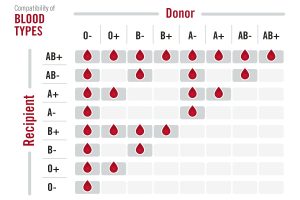As we round out the year, we’re all getting ready to kick back and enjoy our well-deserved break. However, as we celebrate, we also need to remember the true meaning of Christmas, ‘giving’, by helping those in need within our communities. Often overlooked during the holiday period, access to blood becomes increasingly sparse. And unfortunately, due to a short shelf life, the need for blood never takes a break.
Why not start a new Christmas tradition and donate blood? Not only will you feel good about yourself and end the year on a high, you’ll also have done something truly commendable!
Donations by blood types:
The type of blood donation is primarily determined by the donor’s blood type, which will fall into any one of the 8 main blood groups:

When someone is given a blood transfusion, it’s best to give them blood that’s the same type as their own. In cases when that isn’t possible, they can be given other compatible blood types.
Fortunately, some blood types are ‘universal’. These are AB plasma, positive or negative and O negative red blood cells, which are often reserved for emergency situations. These are also the rarest blood types and account for less than 12% of the Australian population. As such, if you fall into either the AB (positive or negative), or O negative blood groups, your blood is in high demand.
What’s involved?
Typically, when we’re talking blood donation, what we’re referring to is whole blood donation.The process is pretty simple, and aside from making sure you’re well rested, nourished and hydrated prior to your appointment, you can try to relax – there’s not a lot more to think about during the process.
As you arrive, there’s some general housekeeping and paperwork before a brief interview with a trained staff member. You’ll do a super quick ‘prick’ to check some levels such as haemoglobin and blood pressure before the donation begins.
The donation itself is relatively simple, however we’re not going to sugar-coat the fact that there is a needle involved – but it really does only hurt a teeny bit for a second. You then can have some ‘you time’ and sit back and relax for the remainder of the procedure (about 15 mins). If you’re donating Plasma and Platelets, this can take a little bit longer as there is a special apheresis process involved in separating the plasma from the blood.
And that’s it! It is best to avoid any strenuous exercise or alcohol for at least 8 hours following your donation. So be sure to save any celebratory drinks for later, and plan around any Christmas events.
Who does it help?
Donations are used to make up to 22 different medical treatments for a variety of conditions, diseases or traumas. These treatments could be used for a serious event such as a major accident like Emily’s, or as the treatment of cancer patients like Vince.
One of the main difficulties for securing donations is that the donors almost never get to see where their donations have gone. So it is always important to remember that you can save a life with a Plasma or Platelet donation, and that a whole blood donation could save up to three lives.
Now… how can you help?
If you would like to give the gift of blood this Christmas, head over to the Australian Red Cross Blood Service or contact your local donor centre to see if you’re eligible to donate and to make an appointment.
If you are hesitant to go by yourself, you can join Red25, a program dedicated to saving lives by uniting workplaces, community groups and universities around Australia. There are group results, tallies and blood challenges allowing for a bit of friendly competition. If your friends or workplace don’t want to get involved, you are still able to join an existing group.
While the idea of donating blood may make some squeamish, doing so will truly give the gift of life this Christmas.
Don’t forget, if there is a particular topic that you would like us to investigate, or if you would like to feature in the wellness blog please feel free to let us know. You can send us an email here.









